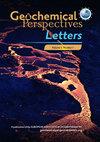铁(III)还原细菌通过呼吸单质硫来固定锑矿
IF 3.7
1区 地球科学
Q1 GEOCHEMISTRY & GEOPHYSICS
引用次数: 2
摘要
铁(III)还原菌(IRB)是通过还原溶解含铁矿物来移动金属(类)的最著名和最有影响力的驱动因素。我们的研究挑战了这一先入为主的观念,发现即使在弱酸性条件下Fe(III)还原盛行,IRB也会通过重新释放元素硫(S0)来固定金属(类)。锑(Sb)是一种有毒污染物,被选为金属(类)的例子。在pH 6.5的S 0存在下,将锑矿吸附针铁矿与广泛分布的IRB Shewanella oneidensis MR-1孵育。结果表明,尽管Fe(III)的还原程度(>100μmol)是Sb 0还原程度(<8μmol)的10倍以上,但Sb 2 S3沉淀固定化的是Sb的还原作用。此外,热力学计算表明,通过形成可溶性硫物种或硫化物沉淀物,这种边际S0还原的巨大影响可以扩展到其他金属(类似物)。本研究重新定义了IRB在金属(类)的环境命运中的作用,强调了边缘S0还原对中心Fe(III)还原的强烈影响。本文章由计算机程序翻译,如有差异,请以英文原文为准。
Iron(III) reducing bacteria immobilise antimonite by respiring elemental sulfur
Iron(III) reducing bacteria (IRB) are best known and most influential drivers for mobi-lising metal(loid)s via reductive dissolution of iron(III)-containing minerals. Our study challenges this preconception and found that IRB immobilise metal(loid)s by respiring elemental sulfur (S 0 ) even when Fe(III) reduction is prevailing under mildly acidic conditions. Antimony (Sb), a toxic contaminant, was chosen as an example of metal(loid)s. Antimonite-adsorbed goethite was incubated with Shewanella oneidensis MR-1, a widely distributed IRB, in the presence of S 0 at pH 6.5. The results show that although the extent of Fe(III) reduction ( > 100 μ mol) was over ten times greater than that of S 0 reduction ( < 8 μ mol), it was S 0 reduction that immobilised Sb through Sb 2 S 3 precipitation. Further, the thermodynamic calculation suggests that such great impacts of marginal S 0 reduction can be extended to other metal(loid)s via the formation of soluble thio-species or sulfide precipitates. This study redefines the role of IRB in the environmental fate of metal(loid)s, highlighting the strong impacts from the marginal S 0 reduction over the central Fe(III) reduction.
求助全文
通过发布文献求助,成功后即可免费获取论文全文。
去求助
来源期刊

Geochemical Perspectives Letters
Earth and Planetary Sciences-Geochemistry and Petrology
CiteScore
7.00
自引率
2.00%
发文量
42
审稿时长
15 weeks
期刊介绍:
Geochemical Perspectives Letters is an open access, internationally peer-reviewed journal of the European Association of Geochemistry (EAG) that publishes short, highest-quality articles spanning geochemical sciences. The journal aims at rapid publication of the most novel research in geochemistry with a focus on outstanding quality, international importance, originality, and stimulating new developments across the vast array of geochemical disciplines.
 求助内容:
求助内容: 应助结果提醒方式:
应助结果提醒方式:


